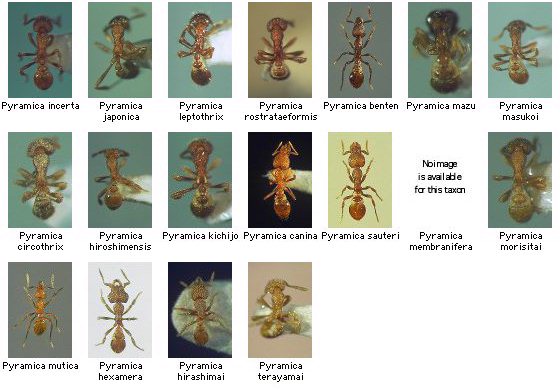
|
genus
|
Pyramica
|
 |

|
|
Japanese Name
|
Ago-uroko-ari-zoku
|
Original Reference
|
|
Roger, J. (1862) Einige neue exotische Ameisen-Gattungen und Arten. Berl.
Entomol. Z., 6: 233-254.
|
Synonym
|
|
Epitritus Emery, 1869,
Trichoscapa Emery, 1869,
Cephaloxys F. Smith, 1865,
Pentastruma Forel, 1912,
Glamyromyrmex W. M. Wheeler, 1915,
Codiomyrmex W. M. Wheeler, 1916,
Tingimyrmex Mann, 1926,
Codioxenus Santschi, 1931,
Smithistruma Brown, 1948,
Weberistruma Brown, 1948,
Wessonistruma Brown, 1948,
Serrastruma Brown, 1948,
Neostruma Brown, 1948,
Dorisidris Brown, 1948,
Miccostruma Brown, 1948,
Kyidris Brown, 1949,
Polyhomoa Azuma, 1950,
Chelystruma Brown, 1950,
Borgmeierita Brown, 1953,
Platystruma Brown, 1953,
Gymnomyrmex Borgmeier, 1954,
Dysedrognathus Taylor, 1968,
Asketogenys Brown, 1972,
Cladarogenys Brown, 1976,
|
Description
|
|
Small ants: total length of workers around 1 - 2 mm. Head subtriangular, with more or less concave posterior margin; dorsum convex. Mandibles variable, usually subtriangular, with numerous small teeth. Antennae 4, 5, or 6 segmented. Eyes located close to ventrolateral margins of head below the antennal scrobes, which are usually distinct. Propodeal spines usually dentiform. Petiole and postpetiole usually with spongiform
material, arranged in discrete blocks on both tergites and sternites. Body hairs simple, clavate, scale-like, orbicular or flagellate; usually bizarre.
|
|

|
Remarks
|
|
Five of the genera synonymised under Pyramica by Bolton (1999) were formerly listed from Japan. They are: Smithistruma, Pentastruma, Trichoscapa, Kyidris, and Epitritus. Bolton (2000) recognized 324 world species. 18 have been reported from Japan.
Most nest in the soil or decaying wood on the ground in broadleaf forests, and most are rare.
|
References
|
|
- Formicidarum italicorum species duae novae. Bullettino della Societą Entomologica Italiana 1: 135-137.
- Enumerazione dei Formicidi che rinvengonsi nei contorni di Napoli. Annali dell'Accademia degli Aspiranti Naturalisti (2) 2: 1-26.
- Smith, F. 1865. Descriptions of new species of hymenopterous insects from the islands of Sumatra, Sula, Gilolo, Salwatty, and New Guinea, collected by Mr. A. R. Wallace. J. Proc. Linn. Soc. Lond. Zool., 8: 61-94.
- H. Sauter's Formosa-Ausbeute: Formicidae. Entomologische Mitteilungen 1: 45-81.
- Wheeler, W. M. 1915. Two new genera of myrmicine ants from Brasil. Bull. Mus. Comp. Zool., 59: 483-491.
- Wheeler, W. M. 1916. Ants collected in Trinidad by Professor Roland Thaxter, Mr. F. W. Urich, and others. Bull. Mus. Comp. Zool., 60: 323-330.
- Mann, W. M., 1926
- Santschi, F., 1931
- Brown, W. L., Jr. (1948). A preliminary generic revision of the higher Dacetini (Hymenoptera: Formicidae). Trans. Am. Ent. Soc., 74, 101-129.
- Brown, W. L., Jr. (1949a. ). Revision of the ant tribe Dacetini. I. Fauna of Japan, China and Taiwan. . Mushi, 20, 1-25.
|
Editor
|
|
Original text by Kazuo Ogata and Keiichi Onoyama. English translation by Kazuo Ogata, edited by Robert W. Taylor. Revised by Masashi Yoshimura.
|
|